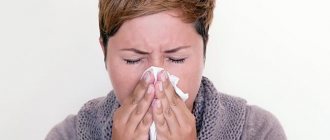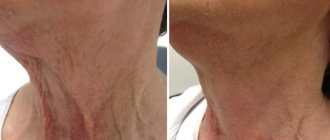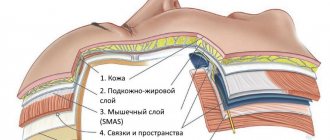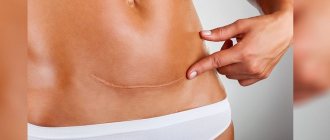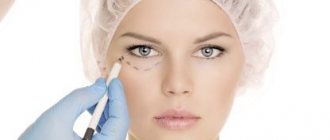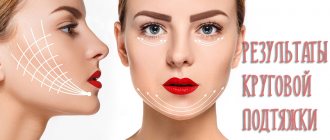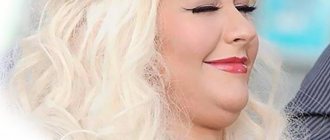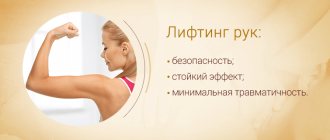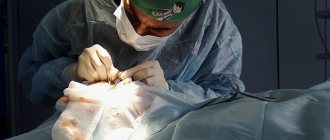Anatomy of the neck
To understand the causes and methods of eliminating a double chin, you need to study anatomy. Don't be afraid, there will be no blood, there will only be visual diagrams.
The soft tissues of the neck consist of 3 layers fused together:
- Leather;
- Subcutaneous fat layer;
- Muscles - platysma.
This is what the muscles look like:
Green muscles are platysma . Platysma consists of two petals. In the above example, you can clearly see the edges of the platysma in the photograph of a person:
How many people there are so many variants of platysma anatomy. For some, the platysma reaches the level of the orbicularis oculi muscles, for others it ends on the chin.
In the neck area there may be the following variations of platysma:
For some, the platysma immediately from the chin is divided into 2 petals, and for others, the petals are fused to each other at some distance.
Platysma consists of fibers - this can be seen in the illustrations above. Fiber density varies from person to person. The lower the fiber density, the thinner the platysma.
Between the two lobes of the platysma and deeper, behind the platysma, there is interplatysmal fat , which differs in structure from subcutaneous fat.
Why does a double chin form?
Platysma is in a relaxed state most of the time: it is practically not involved in facial expressions and chewing processes. Muscles that don't work, as you know, weaken and atrophy.
If you lift your head up, you will feel tension in the front of your neck - this is a tense platysma. It's an unusual feeling, right? Proof that platism rarely works.
With age, in addition to weakening of the platysma, there is a loss of skin elasticity - wrinkles appear. Then the edges of the platysma begin to sag, and a “turkey neck” appears:
If you do not monitor your diet, then the cells of subcutaneous and interplatysmal fat begin to grow. Under the influence of gravity, fat begins to sag. Weakened platysma and skin that has lost elasticity cannot support such a mass and stretches - a double chin is formed.
Let us recall the variants of the structure of platysma:
What do you think: in what case does a double chin appear later?
It’s true, in the latter case (on the right), the prognosis is better - platysma in this version does not form a “turkey neck” and is able to retain more adipose tissue without stretching.
The shape of the facial skeleton also affects the timing of the appearance of a double chin: underdevelopment of the lower jaw leads to premature weakening of the platysma.
In total, how a double chin is formed:
- Platysma weakens, the skin loses elasticity;
- A “turkey neck” appears;
- Growing fat cells stretch and fill sagging skin;
- A double chin is formed.
The structural features of the platysma and lower jaw greatly influence the timing of the formation of a double chin.
Sagging skin like a “turkey neck”, double chin, sagging and neck pain: remove everything!
We pay great attention to body tone and facial skin care. But very often we miss a very important element in maintaining beauty and youth - neck care.
The subcutaneous neck muscle, or platysma, is responsible for the appearance of the neck and chin. It is different from other muscles and is highly susceptible to age-related changes and external damage.
The platysma is not connected to bone tissue and, like all muscles, has a tendency to lose elasticity. The skin of the neck contains fewer sebaceous glands than the face. The lack of sebaceous glands makes this area very prone to dryness and wrinkles. Therefore, it is very important to apply moisturizing creams not only to the skin of the face, but also to the skin of the neck!
Age-related changes primarily manifest themselves in weakness of the subcutaneous muscle of the neck. But changes in it more often lead not to the formation of a double chin, but to sagging skin like a “turkey neck.”
Over time, fatty tissue also accumulates in the lower cheeks and chin area. This leads to circular folds appearing on the skin, making it flabby and wrinkled.
One of the main reasons for the deterioration of neck skin quality is incorrect posture . Since in real life we often look at our feet rather than at the sky, platism has practically no work. And from forced inaction, it weakens, becomes sluggish, sags and ceases to tighten the skin.
Exercises for the subcutaneous muscle of the neck
- Smile, tensing the lower part of your face for 5 seconds, and relax your muscles for the same time. Repeat for a minute. Relaxing the depressor anguli oris muscle produces an effective result in the form of raising the corners of the lips and changes the facial expression to a more positive one. And by also straining the platysma, you redistribute muscle activity and tighten the muscle itself. When carrying out such an exercise, you should remember that the main thing is regularity.
- As you inhale, lower your lower lip and jaw so that the tension in the subcutaneous muscle of the neck is maximum and the tendons are clearly visible in the neck. All other facial muscles should remain relaxed.
Count down 6 seconds to yourself and completely relax your neck while exhaling. Repeat the exercise 4-5 times with breaks of 2-3 seconds between tensions. - Tilt your head forward and press your palms in front of your chest at the level of the 3rd rib. Then inhale, fixing the skin on the ribs with your fingers, slowly lift and move your head back, thus causing tension in the subcutaneous muscle of the neck.
As you exhale, place your head in a vertical position. Repeat the entire cycle of movements 3-6 times. Inhale slowly through your nose and, opening your mouth wide, tilt your head back as far as possible.Then, keeping your head tilted back and exhaling through your nose, slowly close your mouth, bringing the lower jaw and upper jaw together. Returning your head to a vertical position, rest for 2-3 seconds. Repeat the exercise 36 times.
- Simhasana - lion pose. When the tongue sticks out, the tongue muscles are activated, as well as the rectus abdominis, pelvic floor muscles, and muscles that attach to the sternum.
Exhaling forcefully activates the diaphragm, pelvic floor muscles, and the muscles that control the vocal cords. At the same time, the subcutaneous muscle of the neck also contracts.As a result, simhasana stimulates many muscles that usually receive insufficient attention. In addition, simhasana has a tonic effect on the subcutaneous muscle of the neck, which gives a good cosmetic effect.
- Puff out your cheeks as much as possible, close your mouth and begin to move the air in a circle - from the left cheek above the upper lip to the right cheek and from under the lower lip on the right to the left cheek. Then tilt your head back slightly and begin to gently blow out air. Imagine that you are blowing away a speck of dust. Repeat 3-5 times.
Do these exercises every day, and soon you will notice the result: you will have a beautiful and toned neck.
Share this information with your friends, let them also be healthy and beautiful!
Here's something else interesting
— Subscribe to my Instagram. I lead it myself, without assistants. So you will get to know me better, look at my works and reviews, and make the right choice.
